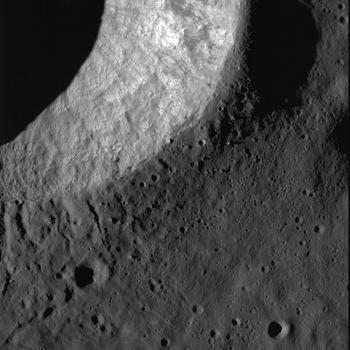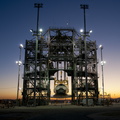
WIKIARCHIVES.SPACE
The Human Spaceflight Archive

The inner rim of Milichius A crater in Mare Insularum. Image width is approximately 6 km wide.
Information
- Taken in
- Author
- NASA/GSFC/Arizona State University
- Description
-
The inner rim of Milichius A crater in Mare Insularum. Image width is approximately 6 km wide.
Milichius A is a Copernican-aged crater found in the middle of Mare Insularum (upper left). There are many different sizes of impact craters in this view, from 9 km in diameter (Milichius A) all the way down to craters that are just a few meters across. The "cracked" appearance of the rim exterior is a result of impact melt flowing after emplacement, and is fairly common in other similarly-sized, relatively young Copernican-aged craters. You can also see that while there are numerous smaller craters on the surrounding ejecta blanket, the interior of the crater seemingly has far fewer craters than the exterior. Does this mean that there have been no impacts on the inner wall of Milichius A? Probably not -- there have almost certainly been many small impacts on the steep surface. Instead, the streaks that you see on the crater walls are places where materials have simply slumped into the crater, covering and obscuring the smaller craters as it slides down the walls of the crater, although some of the darker, low-albedo streaks may actually be impact melt flows.
NASA's Goddard Space Flight Center built and manages the mission for the Exploration Systems Mission Directorate at NASA Headquarters in Washington. The Lunar Reconnaissance Orbiter Camera was designed to acquire data for landing site certification and to conduct polar illumination studies and global mapping. Operated by Arizona State University, the LROC facility is part of the School of Earth and Space Exploration (SESE). LROC consists of a pair of narrow-angle cameras (NAC) and a single wide-angle camera (WAC). The mission is expected to return over 70 terabytes of image data.
- Created on
- Friday 18 September 2009
- Albums
- US SPACE PROGRAM / PROBES / MOON / LRO/LCROSS / Mission Photos (Edited)
- Source link
- https://photojournal.jpl.nasa.gov
- Visits
- 20
- Rating score
- no rate
- Rate this photo
- License
- Public Domain
- Modified by WikiArchives
- No (original)
- Downloads
- 0
Powered by Piwigo





























